Search of topological phenomena in correlated open quantum systems based on quantum entanglement
Department of Physics, Kyoto University
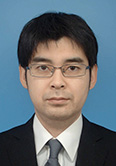
In this decade, topological aspects of condensed matters have extensively studied. In topological phases, such as topological insulators, topologically nontrivial properties induce gapless boundary modes robust against perturbations. In addition to the above significant developments, non-Hermitian systems, such as open quantum systems, attract much interest recently. For such systems, a variety of novel phenomena (e.g., the emergence of exceptional points and the non-Hermitian skin effect) are reported due to the interplay between the non-Hermiticity and the topology. In my project, I address analysis of topological open quantum systems in terms of extreme universe.
In particular, recent developments of technology allow us to experimentally tune dissipation and correlations for cold atoms. In these systems, interplay between strong correlations and non-Hermitian topology would trigger off novel phenomena unique to strongly correlated open quantum systems. I particularly analyze these open quantum systems in search of exotic non-Hermitian topological phenomena. Furthermore, I address theoretical proposals how to experimentally observe such novel phenomena for cold atoms.
By communicating other researcher of extreme universe, I also address the above project from the interdisciplinary viewpoint.
An approach to quantum gravity from quantum information theory and condensed matter theory
Institute for Solid State Physics, the University of Tokyo

General relativity and quantum mechanics are the most important developments in physics in the 20th century. However, quantum gravity, which is the combination of relativity and quantum mechanics, is still not fully understood yet. In this research, we study quantum gravity from the perspective of quantum information and condensed matter physics. Through that, we study how quantum mechanics and general relativity are combined and how spacetime emerges from quantum mechanical systems. Furthermore, we study the implication of quantum gravity on low energy effective theory through the lens of quantum information and condensed matter theory. Based on that, we study how quantum gravity gives predictions for our spacetime and universe as well as elementary particles. We also analyze the quantum information structure in condensed matter and quantum phases out of equilibrium and apply these results to problems in quantum gravity.
More specifically, we study 「[A]application of quantum channels and open quantum systems to quantum gravity」, 「[B]Quantum information and the Swampland program」, 「[C]Quantum information aspects of emergence and phases in condensed matter systems」.
In [A], we study open dynamics in the SYK model and then generalize to the top-down AdS/CFT. Based on those, we understand the emergence of time and the dual of non-unitary theories, which are not well understood. In [B], we aim to understand the swampland program in the language of quantum information theory. Beyond the black hole thermodynamics, we derive the swampland conditions by quantum information approach and quantum entanglement, which are more basic properties in quantum gravity. In [C], we study quantum information structures in emergent gauge fields from condensed matter (spin systems) like Lifsihtz gravity, fracton topological order. Emergent gauge fields are ubiquitous in condensed matter systems. Since gravity is also a gauge field, they are similar in that sense. Through the understanding of quantum information properties in the system with emergent gauge fields, we try to understand quantum gravity.
Application of tensor networks to elementary particle physics
College of Science and Engineering, Kanazawa University
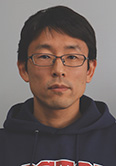
Tensor network (TN) method was originally proposed as a variational method to solve quantum many-body system in the condensed matter physics. At present, various improvements have been made on the method, and its applications have spread to many fields such as elementary particle physics, quantum information, and quantum chemistry. I am particularly interested in applying the TN method to quantum field theory, which is a theoretical foundation of elementary particle physics. My final goal is to obtain the dynamics of the theory, which are difficult to capture with the Monte Carlo method due to the sign problem, from first principle computation using the TN method. Interesting physical systems inherent the sign problem include QCD with finite baryon density, real-time path integral, lattice chiral gauge theory, lattice SUSY, and system having a topological theta term. Currently I am working on revealing a phase structure of CP(1) model with the topological term, which is known as a toy-model of QCD. Although it is expected that the knowledge of QCD can be obtained by analyzing the model, at present the phase structure of CP(1) itself is under debate. Thus, I would like to draw a final conclusion by using a more sophisticated TN method.
While the TN method has no sign problem, it still has a problem of drastic increase in computational cost when applied to higher dimensional system. A key to solve the problem is how to compress the information of tensor. Various ideas have been proposed so far, such as incorporating environment effects and local correlations, or a stochastic method. In this project, I aim to develop a highly efficient coarse-graining algorithm for high dimensional system by interweaving such knowledge.
Study of emergence of spacetime in tensor network based on the renormalization group
Department of Physics, Shizuoka University
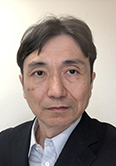
The emergence of space-time is considered to be an essential feature of quantum gravity. It has been recognized that quantum entanglement plays a crucial role there. The gauge/gravity correspondence is a typical example in which the emergence of space-time is realized. The purpose of this project is to make progress in the construction of quantum gravity by studying continuum tensor networks based on the renormalization group in the gauge/gravity correspondence.
Tensor networks models such as the MERA, the HaPPY code and the random tensor network are important in the studies of the emergence of space-time, since the models give networks that can be interpreted as discrete spaces emerging from boundary theories through entanglement entropy. Here it is needed to construct continuum tensor network models to obtain the emergence of continuum space.
The cMERA, a continuum analog of the MERA, is constructed in free field theories by using the variational method, while the variational method seems difficult to apply to interacting theories. Since the layers in the network of the MERA can be interpreted as the scale of renormalization group, which corresponds to the bulk direction, constructing the cMERA is considered to be equivalent to obtaining the scale dependence of wave functionals. In this project, we study the construction of continuum tensor networks based on renormalization group. In particular, we focus on the exact renormalization group and the tensor renormalization group, which can be viewed as a path-integral formulation of the MERA.
We construct the exact renormalization group for wave functionals in quantum scalar field theories, which enables nonperturbative analyses of the wave functionals. We also develop a numerical method to examine the scale dependence of the wave functionals by taking the continuum limit of the tensor renormalization group for lattice field theories. We construct the continuum tensor networks by using these methods and extract the dynamics of gravity from the networks to study the emergence of space through quantum entanglement.
Quantum entanglement and information scrambling in inflationary models
Department of Physics, Naogya University
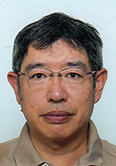
Stochastic approach of inflation treats the quantum inflaton field as a classical stochastic variable. The basic equation of this approach is the Langevin equation for the long wavelength modes of the inflaton field with the stochastic noise from the short wavelength inflaton fluctuations. Hence the evolution of the inflation field has the similar behavior as a Brownian particle. This approach can effectively include large-scale non-linear quantum fluctuations and its validity is discussed from the IR structure of quantum fluctuations in de Sitter spacetime.
Based on the stochastic picture of inflation, there appears the eternal phase in which inflation never terminates due to quantum fluctuations. The realization of the eternal phase depends on parameters of the inflaton potential, and in the eternal phase, the global structure of inflationary spacetime becomes inhomogeneous and very complicated.
Although the stochastic approach of inflation includes quantum effect as the short wavelength random noise, it does not take into account of quantum entanglement, which is a key property of quantum systems. The purpose of this research project is to investigate effect of quantum entanglement on the stochastic picture of inflation. For this purpose, we will employ a qubit model of inflation with quantum entanglement and investigate evolution of entanglement structure of this model. We will also investigate “information” of this model to understand emergence of “classical property” in the stochastic inflation.
Study of quantum theory of gravity based on the Jackiw-Teitelboim gravity theory
Graduate School of Science and Engineering,
Saitama University
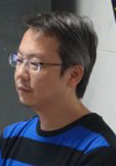
My main research area is superstring theory in elementary particle theory. Superstring theory is considered to be a leading candidate for the ultimate theory that can uniformly describe the four forces that exist in nature: electromagnetic force, weak force, strong force, and gravity. There are various research themes in string theory research, but I am interested in the duality (equivalence) between gauge theory and gravity (string) theory. This duality is realized by the gravitational (string) theory on the Anti-de Sitter (AdS) space and the field theory with conformal symmetry (Conformal Field Theory, CFT) equivalence. This duality was originally proposed by Maldacena. This equivalence is one of the realization examples of the holographic principle, but the basic mechanism of how this principle is realized has not yet been elucidated.
For this mechanism, I have applied mathematical and physical analysis based on the integrable structure that exists behind the duality, chaotic motion and turbulent behavior of strings, and chaotic scattering in gauge theory. We are conducting research from this perspective. It is a very important research topic to understand the relationship between quantum information theory, which is the subject of this research area, and these themes.
The subject of my publicly offered research is to analyze the Jackiw-Teitelboim gravity, a toy model in which dilaton is coupled to two-dimensional gravity, in order to clarify quantum information theory and the holographic principle. There are various choices for the dilaton potential, and our previous research has shown that the sinh-type potential leads to the well-known Liouville gravity. By promoting this research, I would like to explore the relationship with quantum information theory and the clues to clarify the fundamental degrees of freedom in quantum gravity.
Theoretical modeling of optomechanical pendulum for testing quantumness of gravity
Department of Physics, Kyushu University

My research focuses on themes related to the verification of the quantum mechanical properties of gravity. This theme, which revisits the question of whether the gravity follows the framework of quantum mechanics or not, has a long history of deep consideration by Feynman and Penrose, and is a very interesting theme that is related to recent developments in quantum information and quantum technology. Quantum entanglement caused by gravitational interaction is one of the main interests, and I am also conducting theoretical research to clarify its significance for quantum gravity theory and whether it can be verified experimentally. We focus on how a quantum mechanical system interacts through gravity, but since gravity is very weak, it is necessary to realize the quantum state of a macroscopic object. Optomechanical systems play an important role in realizing the quantum states of such macroscopic objects. An optomechanical system is a mechanical system with one end of an optical cavity as a mirror oscillator that interacts with the cavity light. The Michelson interferometer, which combines them, is used in gravitational wave detection, and related research and technology are developing. In the proposal of my research, we are constructing a theoretical model of an optomechanical system with a suspended mirror oscillator called a beam model for the purpose of realizing the quantum state of macroscopic objects and verifying the quantum mechanical properties of gravity in the future. Based on the beam model, we plan to make theoretical predictions of the noise and dissipation to characterize optomechanical mirror oscillators, and of the quantum state when quantum control is performed by feedback control with continuous measurement.
Mesoscopic picture of black holes from quantum information
Department of Physics, College of Humanities and Sciences,
Nihon University
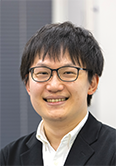
The goal of this publicly offered research is to understand the quantum (microscopic) aspects of black holes and wormholes in terms of holographic principles and quantum information theory.
Black holes have been playing a crucial role to understand the quantum aspects of gravity. In particular, the recent discovery of microscopic wormholes (so-called replica wormholes) associated with black holes has made significant progress toward solving the famous black hole information loss puzzle. This progress is mainly based on the semi-classical (macroscopic) picture, while the quantum (microscopic) picture is still unclear and problematic.
I am now studying “What microscopic properties of the wormholes play an important role?” and “Is there any way to complement the relationship between the micro and macroscopic pictures of wormholes?”. These questions are directly related to the research of Group B.
More specifically, my current research plans are to (1) clarify the microscopic and macroscopic properties of candidate quantum states that describe the microstructure of wormholes in terms of quantum information theoretic quantities and (2) study the quantum operations that “decompose” macroscopic wormholes into microscopic ones and their effects on the wormhole geometries. Interestingly, these topics are closely related to the research of Group C and D, so I am very excited to join this Extreme Universe collaboration which will lead to new research directions. I am also interested in studying “(3) implications of such microscopic wormholes to physics such as symmetries”.
Entanglement Witness in Quantum Frustrated Magnets
Okinawa Institute of Science and Technology Graduate University
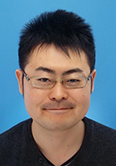
Quantum entanglement has attracted a great deal of attention in recent years. In particular, theoretical studies using entanglement entropy (EE) have revealed that quantum entanglement is important for understanding unique and exotic states in quantum systems, such as quantum spin liquids and topological order. In addition, the concept of quantum entanglement has been shown to be intrinsically important for the development of new numerical methods, such as tensor network methods. On the other hand, it is known that it is challenging to measure EE directly experimentally, except for a small number of systems such as cold atoms or optical systems. Our study focuses on so-called entanglement witnesses (EWs) such as one tangle, concurrence, and quantum Fisher information. These can be written in terms of spin-spin correlation functions and dynamical spin structure factors, which are familiar in the field of magnetism, and are known to be accessible with some experimental techniques such as neutron scattering experiments [1-4]. We focus on quantum states such as quantum spin liquid states and random singlet states, which do not exhibit magnetic orders even at very low temperatures, and for which positive experimental evidence characterizing them is difficult to obtain. Our main purpose of this study is to clarify numerically whether the above EWs can characterize these unique quantum states. We also aim to establish theoretical guidelines that will lead to experimental detection and control methods of the exotic quantum states in candidate materials.
[1] L. Amico et al, Phys. Rev. A 69, 022304 (2004).
[2] W. K. Wootters, Phys. Rev. Lett. 80, 2245 (1998).
[3] P. Hauke et al, Nat. Phys. 12, 778 (2016).
[4] P. Laurell, et al, Phys. Rev. Lett. 127, 037201 (2021).
Study of novel quantum many-body phenomena originating from non-ergodicity in isolated quantum systems
Department of Physics, Tokyo University of Science
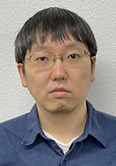
In this publicly offered research, I will study nonergodicity in isolated quantum systems.
The issue of thermalization in isolated quantum many-body systems has become a realistic problem thanks to the developments of various quantum simulators such as cold atoms or molecules in optical lattices, Rydberg atoms in optical tweezers, trapped ions, and superconducting qubits. According to previous studies, if a system satisfies the eigenstate thermalization hypothesis (ETH), the system will thermalize after a long-time evolution. However, to prove the ETH is an unsolved problem. It is also known that some systems do not satisfy the ETH. These systems are called nonergodic systems. Typical examples of nonergodic systems are quantum integrable systems, Anderson localized systems, and many-body localized systems. Recently, quantum many-body scarred systems and Hilbert space fragmented systems have been found as novel ergodicity-broken systems. Inspired by these findings, I will explore novel quantum-many-body phenomena originating from the nonergodicity in isolated quantum systems. In particular, I will study the Hilbert space fragmentation in momentum space, which is different from the previous works. If the Hilbert space fragmentation occurs in the momentum space, we can naively expect that persistent-current states emerge. I will study the nature of the persistent current induced by the Hilbert space fragmentation in momentum space. I also would like to find novel nonequilibrium quantum many-body phenomena and discover a new nonergodic mechanism. In addition to this research, I plan to develop and propose schemes for the experimental implementation of my results obtained in this project.
Theoretical research on methods to measure quantum natures of evaporating primordial black holes by using future observations
IPNS, KEK

Inflation, which is believed to have occurred in the early universe, created quantum curvature (density) perturbations with a magnitude of approximately one part per hundred thousand on a large scale. At the same time, it also produces the cosmic gravitational wave background radiation. As temperature fluctuations caused by curvature perturbations were discovered by previous CMB observations, it is expected to observe B-mode polarization caused by gravitational waves in the future to verify inflation. Recently, the NANOGrav Collaboration reported the possibility of observing gravitational waves that have existed since the beginning of the universe: the NANOGrav experiment has observed significant modulation of radio waves in the nanohertz band over a 12.5 year period by correlating the signals of periodically emitted radio waves by multiple pulsars. If background gravitational waves exist, they stretch and contract space-time, thus modifying the periodicity of the radio waves of those precise pulsars. The observed value was more than seven orders of magnitude larger than the gravitational waves directly created by inflation in the early universe. On the other hand, if the observationally allowed curvature (density) fluctuations δ on small scales produced by inflation can be large (e.g.,δ~0.3. Then, it is possible that an extremely large number of gravitational waves are produced on small scales through second-order nonlinear effects. In our paper (Kohri and Terada, arXiv:2009.11853), we pointed out that this second-order gravitational wave background radiation can explain the observations. Furthermore, the above large density fluctuations are expected to collapse in the early universe to form a black hole of solar mass. This black hole is called a primordial black hole (PBH) to distinguish it from the one of astronomical origin. In fact, gravitational waves are also used as a method to verify this model. These PBHs formed a binary star in the early universe and are now merging. The LIGO-Virgo-Indigo-KAGRA collaboration may find the gravitational waves emitted at that time near future. Thus, the future gravitational wave experiments will soon be used to verify inflation in the early universe and discover PBHs.
Exploration of quantum gravity and quantum matter based on symmetry and information geometry
The University of Electro-Communications,
Graduate School of Informatics and Engineering
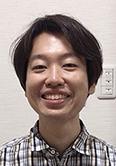
In recent years, Resource Theory of Asymmetry (RTA) has been rapidly developing a comprehensive analysis of the effects of symmetry on quantum mechanics. RTA treats quantum operations which are covariant with respect to given symmetry as free operations, and defines the quantum fluctuation of conserved quantity corresponds to the given symmetry as resource. Recently, I found several trade-off relations in RTA (PRL2018, QIP2020, PRL2021, etc.). The goal of this project is to unify and extend the trade-off relations and apply them to find several useful theorems in quantum gravity and condensed matter theory.
The results obtained to date include a universal trade-off structure between symmetry, irreversibility, and quantum coherence. This trade-off particularly reveals that (1) under a global symmetry, any attempt to induce local dynamics that change the conserved quantity will cause inevitable irreversibility, and (2) such irreversibility could be mitigated by quantum coherence. This relation admits broad applications including measurement, error-correction, gate implementation, thermodynamics, and black hole physics. For example, we apply our relation to black hole physics and obtain a universal lower bound on how many bits of classical information thrown into a black hole become unreadable under the Hayden-Preskill model with the energy conservation law. This particularly shows that when the black hole is large enough, under suitable encoding, at least about $m/4$ bits of the thrown $m$ bits will be irrecoverable until 99 percent of the black hole evaporates. In the future, I aim to extend and apply these results more and more.
Study of physically natural method to generate t-design in quantum many-body systems based on quantum control theory
Department of Computer Science,
Faculty of Informatics, Shizuoka University
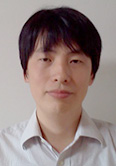
Random unitary transformation is one of the central techniques in quantum information processing. In early stages of quantum information processing research, random unitary transformation based on Haar measure is used. Here, Haar measure is a regular invariant measure on the unitary group. However, it was recognized that the implementation of the random unitary transformation based on the Haar measure requires exponential time. Therefore, unitary t-design, a measure that approximates the Haar measure, has attracted much attention. A t-design are not only essential for various quantum information processing, but have recently been found to be important as a method for approximating quantum chaotic systems and for Markovizations of environmental systems.
Existing t-design generation protocols are designed as polynomial-time algorithms that work efficiently on a quantum computer. However, it difficult to implement them on a quantum many-body system. In this project, we are focus on finding a physically more natural way to generate t-designs in quantum many-body systems than existing methods, with applications such as Markovianization and quantum chaos in mind. First, by applying the techniques of quantum control theory, we prove the existence of a random control method such that the random dynamics of the whole system is t-design in a fully controllable quantum system. In a quantum many-body system, it is natural to assume a situation in which a random action is externally applied only to the restricted degrees of freedom. Therefore, by using the random control method proved above, we show that t-design of the whole system can be achieved by random unitary transformations to small subsystems in well-known one-dimensional and two-dimensional spin systems. Furthermore, we aim to apply the obtained new t-design generation method to quantum information processing. In particular, by creating parametric quantum circuits based on the new method, we aim to devise a new quantum many-body device that can perform variational quantum algorithms by accessing only a part of the system.
Information-theoretical analysis of one-dimensional tensor network
Department of Mathematical Informatics,
Graduate School of Informatics, Nagoya University
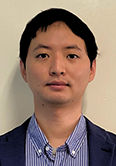
Tensor networks are an efficient representation to describe quantum many-body states or operators with a small number of parameters. They are widely used in ExU researches too, to analyze the dynamics of quantum many-body systems and the holography principle. The use of tensor networks has been spreading to various fields of physics in recent years, but even in relatively simple cases such as one-dimensional (1D) networks, there are still many unresolved aspects in the theoretical foundation.
In this publicly offered research, we will clarify what kind of quantum states can be described by 1D tensor networks, called MPO. In 1D systems, two major types are known: MPS and MPO (there is also another type called MERA, but we do not discuss it here). It is theoretically known that the quantum states that can be efficiently represented by MPS coincide with the low-temperature states (ground states) of 1D systems. This indicates not only that MPS is suitable for describing low-temperature states, but also that MPS is not suitable for describing other states, which is a limitation of MPS's expressive capability. In contrast, MPO is a tensor network suitable for describing thermal states in 1D systems. However, it is known that the states described by MPO include states beyond that, and it is not clear to what exactly the physical states described by MPO. The problem of the description range of tensor networks is not well understood except for MPS, and this research will tackle this unsolved problem for MPO as a first step.
Interestingly, MPO is also related to the physics of 2D spin systems. It has been pointed out that the physical properties of 2D noncritical systems at low temperatures are reflected in the 1D system at the boundary of the system. The 1D state at the boundary is described by MPO, so we plan to address the "holographic" correspondence between such 2D low-temperature states and 1D thermal states in the latter half of this proposal.
Development of quantum many body system out-of-equilibrium and quantum information control with NMR
Department of Physics, Nagoya University
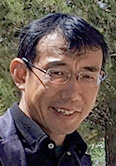
Nuclear spins weakly interact with electron spins through hyperfine interactions in the energy scale of MHz-GHz. The hyperfine interactions include a variety of information associated with the electronic structure and symmetry. Our research group utilizes nuclear magnetic resonance (NMR) as the local probe of symmetry breaking and low energy excitation in condensed quantum matters by determining and solving the hyperfine interaction. Our target materials are the system having macroscopic quantum entanglements such as quantum Hall effects and quantum spin liquids without showing conventional long-range orders. These states can carry anyons with fractional statistics, which are important for the fault-tolerant quantum computation. Our aim is to observe such an emergent quasiparticle by NMR spectroscopy. Although the quantum Hall effect has been realized only on two-dimensional systems, the recent discovery of three-dimensional Dirac semimetals having linear energy dispersion opens the door for magnetic studies by NMR etc. Indeed, we have observed the quantized motion of Dirac fermions in the NMR relaxation rates at high fields and low temperatures. In quantum spin liquids, there is no electric charge carrier but spin excitation. It has a topological order with the long-range quantum entanglement for a gapped spin liquid case analogous to the quantum Hall regime. We have found some candidate materials exhibiting as quantum spin liquid in frustrated spin systems. Can nuclear spins mediate the long-range entanglement of electrons? In this project, we will develop the new open quantum many-body system by combining the macroscopic quantum states and nuclear spins, which is useful to read out the quantum information.
Generation of graph states using cold Rydberg atoms and the application to measurement-based quantum computation
Institute for Molecular Science

In this research, we will perform an experiment to generate many-body entanglement states, called "graph states," which are important resources for quantum error correction and measurement-based quantum computation, via natural time evolution with the interaction between cold Rydberg atoms.
In the cold-atom experimental platform, it is possible to construct a qubit array with the optical tweezers array technique, where locally focused laser beams are used to trap each atom individually and arrange them in an arbitrary shape. Long-range interactions can also be induced between atoms by exciting them to a highly-excited electronic state called a Rydberg state. In this experiment, we produce a large-scale entanglement over the atomic qubit array and generate the graph state via a time evolution under the long-range Ising interaction between atoms.
We excite cold Rubidium atoms trapped in an optical tweezers array to the Rydberg state by pulsed lasers, which induce Ising-type long-range interactions between the atoms and time evolution to generate large-scale entanglement over the atomic qubit array, creating the graph state. By using pulsed lasers to excite the atoms in a short time compared to the time scale of the atomic interactions, we can ignore the Rydberg interactions during the excitation, subsequently inducing interactions between the atoms simultaneously, while continuous wave lasers are generally used in the Rydberg excitation. This is different from the conventional method of performing two-qubit gates for each individual qubit pair and forming entanglement sequentially. We investigate the optimal Rydberg electronic states, state manipulations, and graph geometries for graph state generation. We characterize the fidelity of the generated states by combining single-site addressing single-qubit gate operations.
In addition, we implement individual local measurement that does not affect other atoms in the neighborhood, and explore the possibility of using the generated graph states as a resource for measurement-based quantum computation.
Gravitation and cosmology: principles and applications based on quantum information (21H05189)
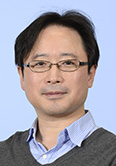
General Relativity proposed by A. Einstein is the most convincing classical theory of gravity describing the dynamical fluctuations of space and time. Cosmological models based on General Relativity have successfully explained a bunch of phenomena observed in the Universe. Nevertheless, some fundamental issues remain long-standing puzzles. Of most prominence is the origin of the two phases of the accelerated expansion of the early and late universe, a.k.a. inflation and dark energy. This exposes a lack of our profound understanding of gravity and spacetime. In this project, we therefore aim to clarify the whole consistent picture of gravity and spacetime, which would make progress toward resolution of the beginning and the accelerated expansion of the Universe.
The research proposal of our group (C3) is two-fold: one is to incorporate the aspects of quantum information—which has been substantially developed during the past decade by the Ryu-Takayanagi formula in the gauge/gravity correspondence—into “braneworld.” A braneworld describes our 4-dimensional universe as a thin membrane corresponding to the boundary of higher dimensional anti-de Sitter spacetime. This model has been motivated by and consistently derived from particle physics. We try to reframe the braneworld model from the perspective of quantum information theory. It is our hope that this new braneworld perspective would be a powerful tool and provide a clue to get deeper insight into problems of universe.
Another blueprint of our research proposals is to identify the direct signature of quantum gravity by exploring a broad range of topics on gravitational physics. The recent experimental activities including the detection of gravitational wave signals and the image of supermassive black holes have reached a sensitivity where the deviation from General Relativity is testable. Stimulated by this new exciting window of opportunity in cosmology/astrophysics, we address phenomena that lead to the robust predictions of quantum aspects of gravity.
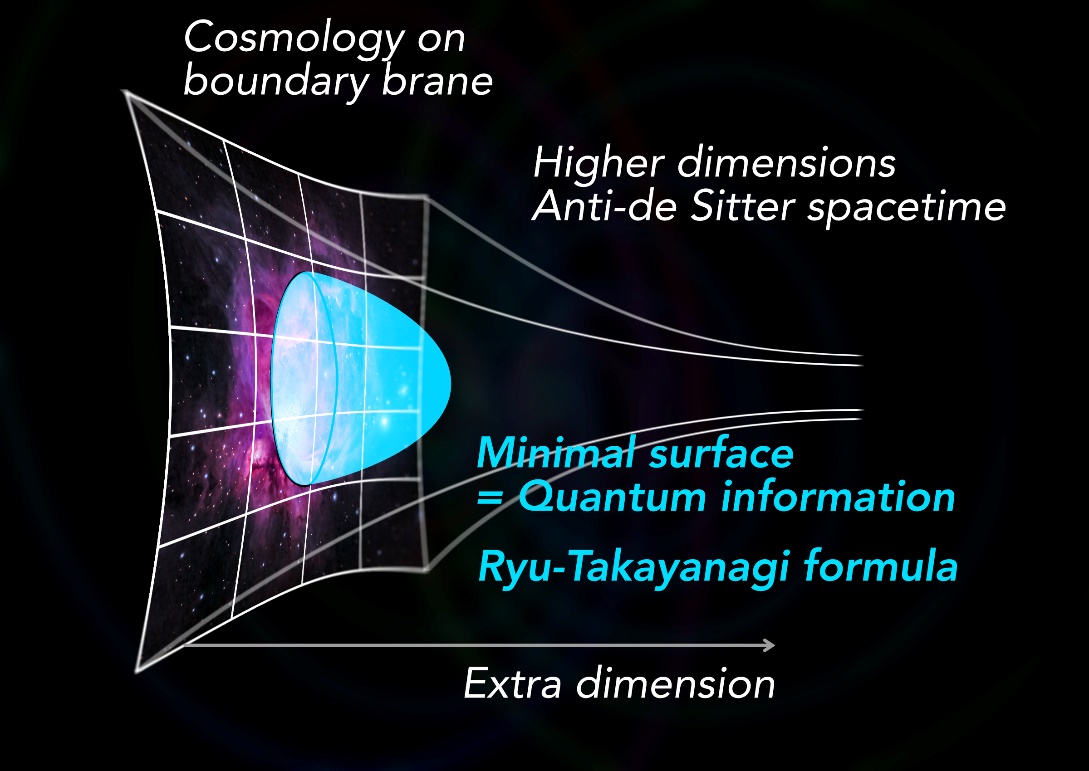
Members in C03
[Principal Investigator]
Tetsuya Shiromizu Graduate School of Mathematics, Nagoya University
[Co-Investigator]
Keisuke Izumi Graduate School of Mathematics, Nagoya University
Tsutomu Kobayashi Department of Physics, Rikkyo University
Masato Nozawa Faculty of Engineering, Osaka Institute of Technology
Norihiro Tanahashi Graduate School of Science, Kyoto University
Hirotaka Yoshino Graduate School of Science, Osaka Metropolitan University
[ExU Postdoctoral Fellows(Research Collaborators)]
Daisuke Yoshida Graduate School of Mathematics, Nagoya University
[Research Collaborators]
Sumio Yamada Faculty of Science, Gakushuin University
[Graduate Students]
Kensuke Sueto Graduate School of Science, Osaka Metropolitan University
Stig Lundgren Graduate School of Mathematics, Nagoya University
[Past Members]
Shunichiro Kinoshita Chuo University
Norichika Sago Kyoto University / Osaka Metropolitan University
Diego Soligon Graduate School of Mathematics, Nagoya University
Lei Fu Graduate School of Mathematics, Nagoya University
Masaya Amo Yukawa Institute for Theoretical Physics, Kyoto University
Tensor Networks and Quantum Many-Body Systems from Quantum Information (21H05191)
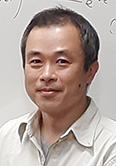
Quantum many-body systems such as quantum spin systems, ultra-cold atoms, and topological quantum matter, have been a central issue in modern condensed matter physics. The key to understanding such complex systems is the structure of quantum entanglement. The primary goal of group D02 is to precisely understand the physics of quantum many-body systems based on a quantitative analysis of quantum entanglement. For this purpose, we focus on tensor networks (TNs) that provide very practical numerical and theoretical frameworks for describing and controlling entangled many-body states. Recent years have witnessed a growing interest in applying TNs to various fields, ranging from quantum information to high-energy physics. In particular, the fusion of different fields has led to nontrivial results such as the relation between the Ryu-Takayanagi formula and the entanglement renormalization group, one of the TN methods. In this research project, motivated by such interesting interdisciplinary developments, we will systematically clarify the controlling mechanism of quantum many-body states using TNs, and then develop a modern theory of quantum many-body dynamics by focusing on mathematical structures behind the TNs and quantum entanglement. Also, we will address TN algorithms for higher dimensions and critical systems. In cooperation with other research groups, moreover, we explore condensed matter analogies of quantum gravity phenomena in realistic experimental situations, which would provide a possible understanding of quantum universe from the condensed matter perspective.
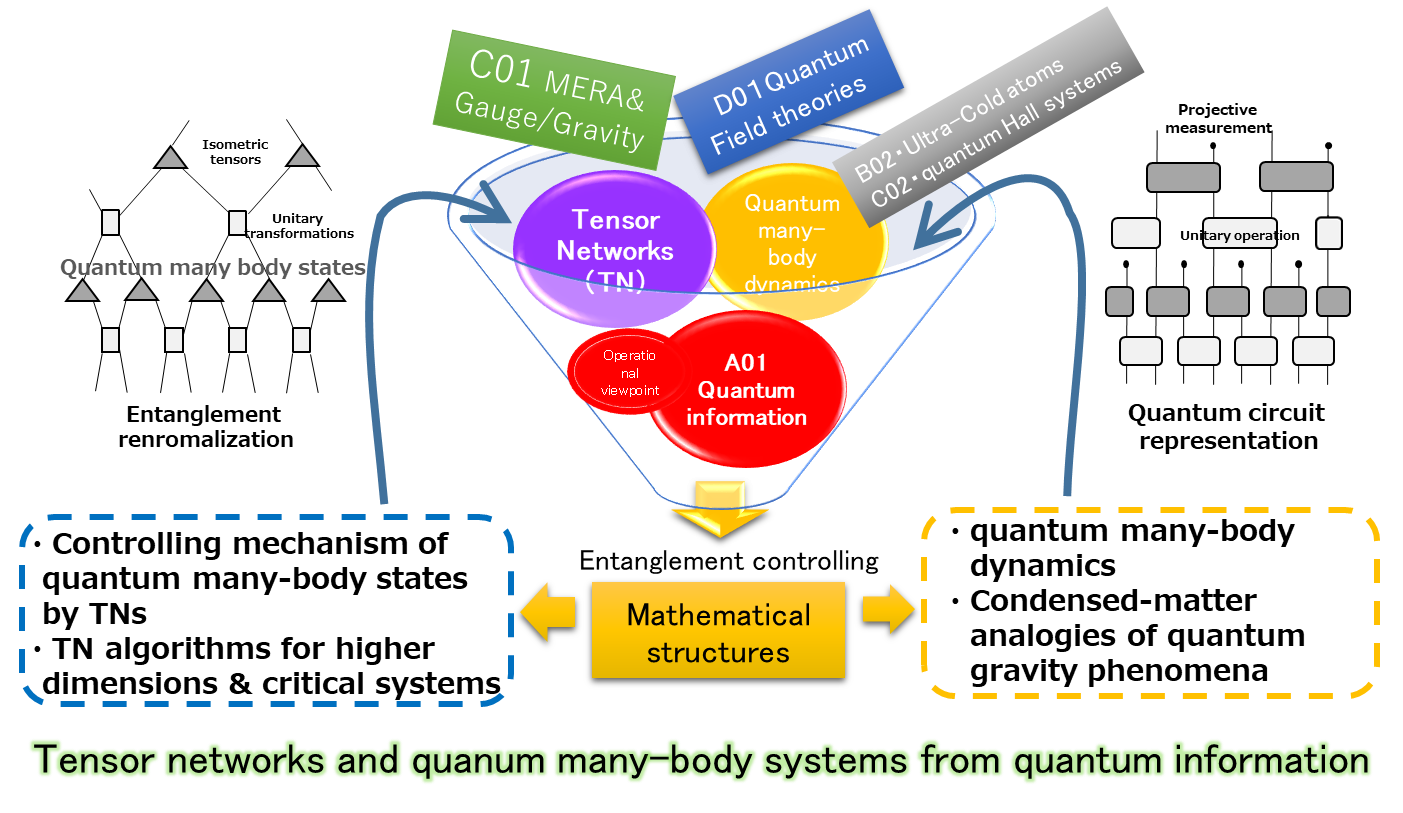
Members in D02
[Principal Investigator]
Kouichi Okunishi Graduate School of Science, Osaka Metropolitan University
[Co-Investigator]
Kenji Harada Graduate School of Informatics, Kyoto University
Chisa Hotta Graduate School of Arts and Sciences, The University of Tokyo
Hosho Katsura Graduate School of Science, The University of Tokyo
Hiroshi Ueda Center for Quantum Information and Quantum Biology, Osaka University
[ExU Postdoctoral Fellows(Research Collaborators)]
Soshun Ozaki, Graduate School of Arts and Sciences, The University of Tokyo
Kohei Fukai Graduate School of Science, The University of Tokyo
[Research Collaborators]
Toshiya Hikihara, Faculty of Science and Technology, Gunma University
Tomotoshi Nishino, Department of Physics, Kobe University
Tsuyoshi Okubo, Graduate School of Science, The University of Tokyo
Shunsuke Furuya Saitama Medical University
Atis Yosprakob Yukawa Institute for Theoretical Physics, Kyoto University
[Graduate Students]
Takuma Kaise Graduate School of Natural Science, Niigata University
[Past members]
Atsushi Iwaki, Graduate School of Arts and Sciences, The University of Tokyo
Koutaro Nakajima, Graduate School of Natural Science, Niigata University
Quantum Black Holes from Quantum Information (21H05184)
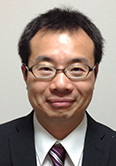
Black Holes are probably the most mysterious and interesting objects in the universe. Classically due to their strong gravitational forces, once you enter through the black hole horizon, you can never go out. However if one considers the quantum effects, this is not true anymore. In fact a black hole has definite temperature and radiates thermally (which is so-called Hawking radiation). Furthermore, a black hole has huge entropy, suggesting that a black hole is in fact a coarse-grained description of degenerate states, whose degeneracy is given by exponential of the entropy, according to the Boltzmann’s entropy formula. These suggest that one should also have a fine-grained description of gravity, which is quantum gravity and string theory is the most successful candidate for it. Recent studies show that two important concepts play an important role in understanding quantum gravity/string theory. One is quantum information. The other is gauge/string duality, which claims that certain quantum gravity is equivalent to certain gauge theory. Our main research goal is using these two important concepts, to understand the physics behind the horizon of quantum black holes, and how quantum mechanics is consistent with gravity. More concretely we would like to figure out the answer for the following key questions; how the physical information of the black hole leaks out through the Hawking radiation? How quantum gravity corrects Hawking’s mistake? What are the laws of physics behind the black hole horizon? Through the study of quantum black holes, we would like to understand the basic principles for quantum gravity.
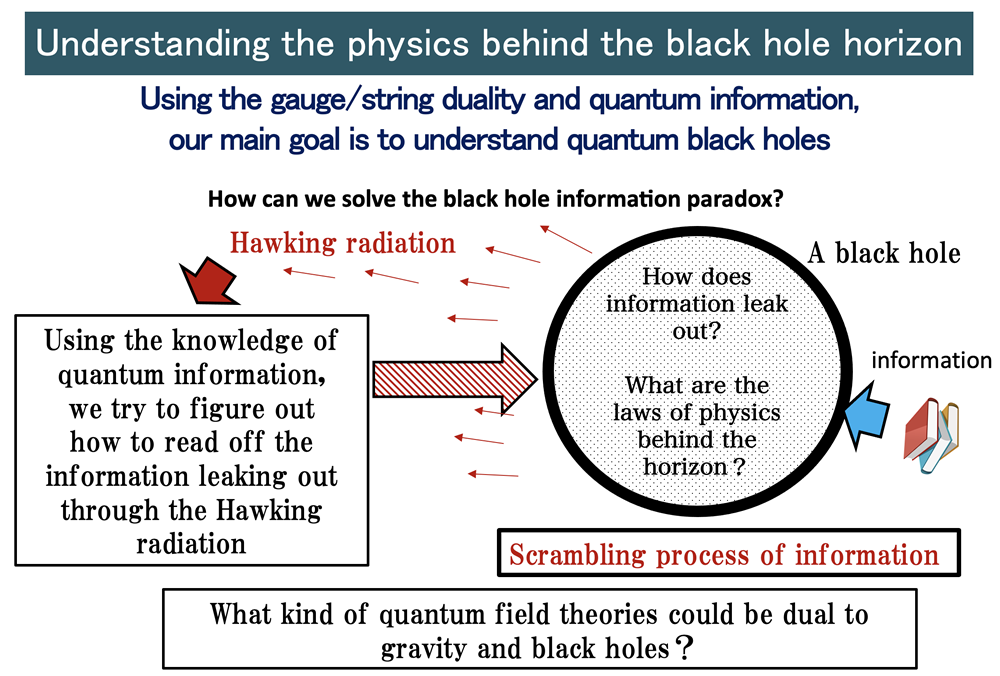
Members in B01
[Principal Investigator]
Norihiro Iizuka Department of Physics, National Tsing Hua University / Yukawa Institute for Theoretical Physics, Kyoto University
[Co-Investigator]
Toshifumi Noumi Graduate School of Arts and Sciences, The University of Tokyo
Masaki Shigemori Department of Physics, Nagoya University
Seiji Terashima Yukawa Institute for Theoretical Physics, Kyoto University
Tomonori Ugajin Department of Physics, Rikkyo University
[ExU Postdoctoral Fellows(Research Collaborators)]
Akihiro Miyata Yukawa Institute for Theoretical Physics, Kyoto University
Sunil Kumar Sake Yukawa Institute for Theoretical Physics, Kyoto University
Nicolò Zenoni Yukawa Institute for Theoretical Physics, Kyoto University
[Research Collaborators]
Takanori Anegawa National Institute of Technology, Yonago College
Koji Hashimoto Department of Physics, Kyoto University
Kengo Maeda Faculty of Engineering, Shibaura Institute of Technology
Mitsuhiro Nishida National Institute of Technology, Yuge College
Kotaro Tamaoka College of Humanities and Sciences Department of Physics, Nihon University
[Graduate Students]
Ryo Nemoto Department of Physics, Nagoya University
Quantum information theoretic approach to the dynamics of quantum field theory (21H05190)
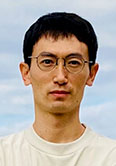
Many of the phenomena around us, such as the Standard Model of elementary particles, are described in terms of quantum field theory. Understanding the physics of the microscopic realm is important not only for investigating the ultimate constituents of matter, but also for exploring the nature of quantum many-body systems, in which many fundamental quantum systems cooperate with each other to create new physical phenomena. The goal of group D01 is to elucidate the dynamics of matter that exhibits such quantum behavior. In quantum information theory, how quantum systems change under various physical manipulations is investigated from a general viewpoint. By adopting the perspective of quantum information theory, new aspects of quantum field theory may be revealed that cannot be understood by conventional methods. In particular, by focusing on the common mathematical structure behind quantum field theory and quantum information theory, we hope to uncover universal properties that all field quantum theories should possess, independent of individual quantum systems. As a complementary approach to examining the dynamics of quantum field theories, we will perform quantum computer simulations of quantum field theories. Many physical systems, including finite density systems and real time systems, are difficult to simulate on classical computers, but are expected to be efficiently simulated on quantum computers. By developing and implementing methods of quantum computation suitable for quantum field theory, we will be able to elucidate important phenomena such as the scattering process of elementary particles and the evaporation process of black holes. Furthermore, we will explore the relationship between the quantum information theory aspect of quantum field theory and holographic principles as well as quantum gravity theory.
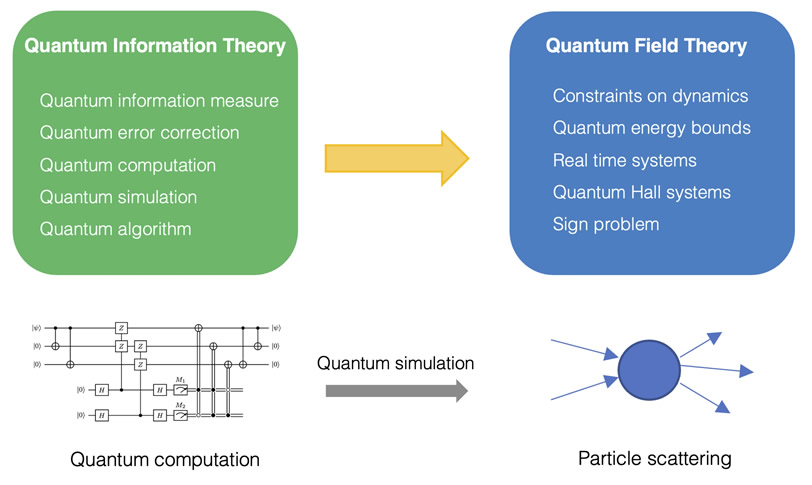
Members in D01
[Principal Investigator]
Tatsuma Nishioka Department of Physics, Osaka university
[Co-Investigator]
Masazumi Honda RIKEN, iTHEMS
Etsuko Itou Yukawa Institute for Theoretical Physics, Kyoto University
Yutaka Matsuo Department of Physics, The University of Tokyo
Takuya Okuda Graduate School of Arts and Sciences, The University of Tokyo
[ExU Postdoctoral Fellows(Research Collaborators)]
Pratik Nandy RIKEN iTHEMS
Dongsheng Ge Department of Physics, Osaka University
[Research Collaborators]
Akira Matsumoto Education Promotion Division, Osaka Metropolitan University
Kazunobu Maruyoshi Faculty of Science and Technology, General Education, Seikei University
Lento Nagano International Center for Elementary Particle Physics, The University of Tokyo
Ryo Suzuki Shing Tung Yau Center of Southeast University
Masahito Yamazaki Department of Physics, The University of Tokyo
Yutaka Yoshida Faculty of Law, Meiji Gakuin University
Atis Yosprakob Yukawa Institute for Theoretical Physics, Kyoto University
[Graduate Students]
Keiichi Ando Department of Physics, Osaka University
Harunobu Fujimura Department of Physics, Osaka University
Rumi Hasegawa Graduate School of Science and Technology, Niigata University
Taichi Nakanishi Yukawa Institute for Theoretical Physics, Kyoto University
Soichiro Shimamori Department of Physics, Osaka University
Hiroki Sukeno Stony Book University
Takahiro Tanaka Yukawa Institute for Theoretical Physics, Kyoto University
Shinichiro Yahagi Department of Physics, The University of Tokyo
[Past Members]
Takahiro Doi Research Center for Nuclear Physics, Osaka University
Daisuke Inotani The Research and Education Center for Natural Sciences, Keio University
Naohisa Sueishi Keio University
Hiroyuki Tajima Department of Physics, The University of Tokyo
Shouichiro Tsutsui iTHEMS, RIKEN
Kohki Kawabata Department of Physics, The University of Tokyo
Quantum cosmology experiments in quantum Hall systems (21H05188)

How did our universe develop from its earliest moments? This is the major question of quantum cosmology, and to answer it great efforts have been made both in theory and in attempts to verify theory by observation of cosmic background radiation. It would be ideal if we could reproduce the origin and evolution of the universe in a laboratory and thereby experimentally verify the theory by controlling key parameters. Therefore, in this research project we aim at implementing quantum cosmology in the laboratory in a toy model which is a theoretically equivalent physical system to the early universe. In this way we seek to provide a rich playground for verification of quantum cosmology theory.
The actual physical system that we deal with comprises electrons in semiconductors. Semiconductor industry consists of state-of¬-the-art modern technologies such as ultra-high quality crystal growth technology, fine process technology, and electronics. In this project, using such mature technologies as a base, we implement toy models of quantum cosmology on a semiconductor chip using quantum Hall edges, which are an intriguing quantum many-body system. Through experiment and theory, we aim at unveiling the mechanism of the origin of the universe. More specifically, (1) we will establish advanced quantum measurement techniques and perform experiments on quantum Hall edges, and (2) examine quantum cosmology by collaborating with various fields of researchers from particle theory, mathematical physics, solid-state theory, quantum information, and cosmology
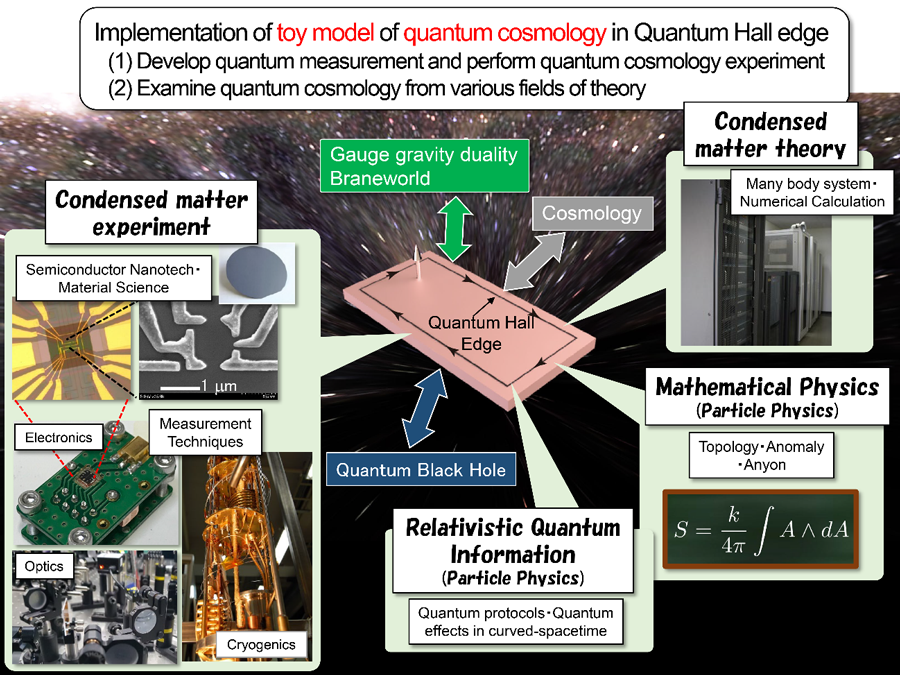
Members in C02
[Principal Investigator]
Go Yusa Department of Physics, Tohoku University
[Co-Investigator]
Naokazu Shibata Department of Physics, Tohoku University
Masahiro Hotta Department of Physics, Tohoku University
Kazuya Yonekura Department of Physics, Tohoku University
[Research Collaborators]
Takaaki Mano National Institute for Materials Science
Kazuhiro Yamamoto Department of Physics, Kyushu University
Yasusada Nambu Department of Physics, Nagoya University
Chisa Hotta Graduate School of Arts and Sciences, University of Tokyo
Kazunori Nakayama Department of Physics, Tohoku University
Vladimir Umansky Weizmann Institute of Science
Koji Yamaguchi The University of Electro-Communications
Kenichi Sasaki NTT Basic Research Laboratories
Kazuaki Takasan Department of Physics, University of Tokyo
Yuki Sugiyama The Institute for Solid State Physics, the University of Tokyo, Specially Appointed Research Fellow
Nicholas Moore Department of Physics, Tohoku University
[Students]
Yuka Kaku Department of Physics, Nagoya University
Yuki Osawa Department of Physics, Nagoya University
Yunhyon Jeong Department of Physics, Tohoku University
Yuichi Sata Department of Physics, Tohoku University
Takahiro Yokokura Department of Physics, Tohoku University
Kazunori Akiyama Department of Physics, Tohoku University
Hiromasa Tajima Department of Physics, Nagoya University
Masaki Fukuda Department of Physics, Tohoku University
Quentin France Department of Physics and Mathematics, Sorbonne University
Kodai Sugizaki Department of Physics, Tohoku University
Komei Kobayashi Department of Physics, Tohoku University
Yuma Hiraga Department of Physics, Tohoku University
Tsubasa Sugeno Department of Physics, Tohoku University
Taiki Karezaki Department of Physics, Tohoku University
Riku Yoshimoto Department of Physics, Nagoya University
[Past Members]
Donghyeon Kim Department of Physics, Tohoku University
Jun Tsujimura Department of Physics, Nagoya University
Akinori Kamiyama Department of Physics, Tohoku University
Ikuya Marumoto Department of Physics, Tohoku University
Yasuaki Hayafuchi Department of Physics, Tohoku University
Ryota Konno Department of Physics, Tohoku University
Reiji Kawada Department of Physics, Tohoku University
Yutaro Takahashi Department of Physics, Tohoku University
Felix Borchers Heidelberg University
Shun Kobayashi Department of Physics, Tohoku University
Kento Watanabe Department of Physics, Tohoku University
Ayaka Kondo Department of Physics, Tohoku University
Kairi Kaneta Department of Physics, Tohoku University
Taesung Koh Department of Physics, Tohoku University
Tomoya Suzuki Department of Physics, Tohoku University
Quantum Cosmology from Quantum Information (21H05187)
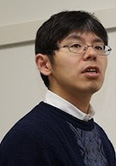
The geometric formula of entanglement entropy (Ryu-Takayanagi formula), which connects quantum information and gravity theory, has led to the prediction that the universe in gravitational theory is a collection of quantum information, which has attracted worldwide attention. The aim of group C01 is to develop this prediction by introducing the viewpoint of quantum information into high energy theory, and to uncover the basic theory of the "dynamics of the creation of the universe (quantum universe)," which is one of the three problems of extreme universe. The foundation for this is the "gauge-gravity correspondence," or the hypothesis that the gravitational theory of the anti de Sitter universe is equivalent to a theory of quantum many-body system. The gauge-gravity correspondence is a powerful idea that has passed enormous verifications, but the basic principle of why this correspondence arises still remains unknown. If this principle is understood completely, it will be possible to elucidate the mechanism of the creation of the universe from nothing and eventually to construct the ultimate physical laws. The anti-de Sitter universe is a universe with negative curvature, while the real universe we live in and the process of creation of the universe are thought to have positive curvature, i.e., a de Sitter universe. In this research, we will first clarify the basic principle of gauge-gravity correspondence by combining the methods of quantum information theory and gauge-gravity correspondence, and then use it as a hint to extend the gauge-gravity correspondence beyond the anti-de Sitter universe to more general universes including the de Sitter universe. This will finally provide us with the fundamental theory for quantum cosmology.
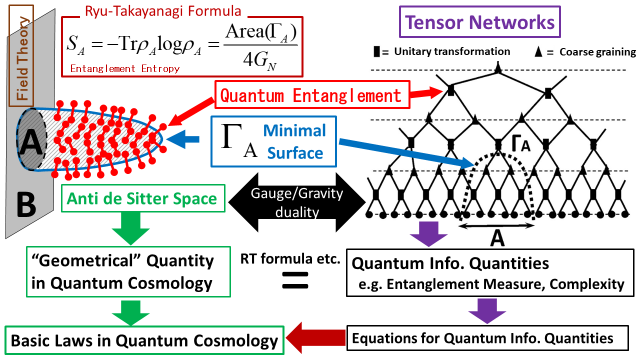
Members in C01
[Principal Investigator]
Tadashi Takayanagi Yukawa Institute for Theoretical Physics, Kyoto University
[Co-Investigator]
Yasuaki Hikida Osaka Institute of Technology
Kazumi Okuyama Faculty of Science, Shinshu University
Yasuhiro Sekino Faculty of Engineering, Takushoku University
Shigeki Sugimoto Department of Physics, Kyoto University
[International Research Collaborators]
Shinsei Ryu Princeton U., USA
Beni Yoshida Perimeter Institute, Canada
[ExU Postdoctoral Fellows(Research Collaborators)]
Jonathan Harper Yukawa Institute for Theoretical Physics, Kyoto University
[Research Collaborators]
Kanato Goto University of Osaka
Tomotaka Kitamura Institute of Theoretical Physics, Rikkyo University
Shoichiro Miyashita Graduate School of Advanced Science and Engineering, Waseda University
Kazuhiro Sakai Institute of Physics, Meiji Gakuin University
Takahiro Uetoko National Institute of Technology, Kagawa College
Masamichi Miyaji Yukawa Institute for Theoretical Physics, Kyoto University
Kenta Suzuki Department of Basic Science, College of Arts and Sciences, The University of Tokyo
Shan-Ming Ruan Peking University
Ali Mollabashi IPM - Institute for Research in Fundamental Sciences, Iran
Pawel Caputa Stockholm University
Zixia Wei Harvard University
Takato Mori College of Science, Rikkyo University
Yuya Kusuki Institute for Advanced Study, Kyushu University
Yasuaki Nakayama NTT Communication Science Laboratories
Peng-Xiang Hao Tsinghua University / Yukawa Institute for Theoretical Physics, Kyoto University
Masashi Kawahira Department of Physics, Kobe University
[Graduate Students]
Taishi Kawamoto Yukawa Institute for Theoretical Physics, Kyoto University
Naoki Ogawa Yukawa Institute for Theoretical Physics, Kyoto University
Yu-ki Suzuki Yukawa Institute for Theoretical Physics, Kyoto University
Takashi Tsuda Yukawa Institute for Theoretical Physics, Kyoto University
Kazuki Doi Yukawa Institute for Theoretical Physics, Kyoto University
Hiroki Kanda Yukawa Institute for Theoretical Physics, Kyoto University
Kotaro Shinmyo Yukawa Institute for Theoretical Physics, Kyoto University
Kenya Tasuki Yukawa Institute for Theoretical Physics, Kyoto University
Ryota Maeda Yukawa Institute for Theoretical Physics, Kyoto University
Michitaka Kohara Yukawa Institute for Theoretical Physics, Kyoto University
Nanami Nakamura Yukawa Institute for Theoretical Physics, Kyoto University
Kosei Fujiki Yukawa Institute for Theoretical Physics, Kyoto University
Ryo Li Yukawa Institute for Theoretical Physics, Kyoto University
[Past Members]
Masahide Sato Yukawa Institute for Theoretical Physics, Kyoto University
Ibrahim Akal Yukawa Institute for Theoretical Physics, Kyoto University
Yoshiki Sato Yukawa Institute for Theoretical Physics, Kyoto University
Yusuke Taki Yukawa Institute for Theoretical Physics, Kyoto University
Understanding quantum black holes through the study of artificial quantum matter (21H05185)
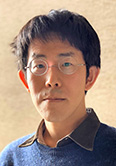
A black hole gradually evaporates into thermal radiation, which is called the Hawking radiation, and finally disappears. This means that whatever information thrown into a black hole will eventually be “lost”. However, this contradicts the unitary time evolution, with the information on the initial state being conserved, in quantum mechanics. This apparent contradiction is called the “black hole information loss paradox”. Clarifying the mechanism by which information appears to be lost is one of the major objectives of this research area which aims to construct a theory of the “extreme universe” that integrates quantum theory and gravity theory.
The aim of group B02 is to promote the study of the quantum features of black holes, one of the key issues of the “extreme universe”, through the collaboration of cold atom experiments and theoretical studies. According to the gauge–gravity correspondence, the evaporation process of a black hole could correspond to the dynamics of a quantum matter.
Therefore, we will elucidate the nature of black holes by experimentally investigating the non-equilibrium dynamics of cold atomic systems in the laboratory which is a highly-controllable artificial quantum matter.
We will experimentally and theoretically perform research on (I) measurement-induced quantum phase transitions due to the effects of dissipation and/or measurement and (II) out-of-time-ordered correlation as the characterization of the delocalization of quantum information in cold atomic systems. In parallel, we will develop the theory for non-equilibrium phase transitions, methods for calculating non-equilibrium states using quantum computers, and evaluate the quantum entanglement in quantum many-body systems that are thought to correspond to quantum black holes and gauge gravity, such as the Sachdev-Ye-Kitaev model.
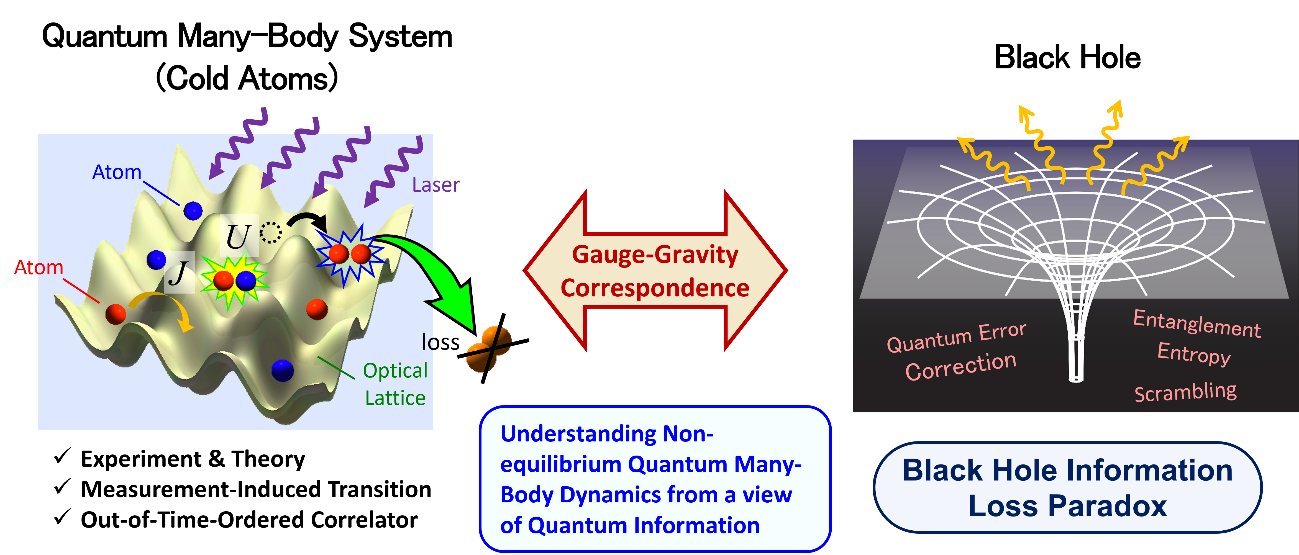
Members in B02
[Principal Investigator]
Masaki Tezuka Department of Physics, Kyoto University
[Co-Investigator]
Shuta Nakajima Center for Quantum Information and Quantum Biology, Osaka University
Eriko Kaminishi Quantum Computing Center, Keio University
Takashi Mori Department of Physics, Keio University
Daisuke Yamamoto Department of Physics, Nihon University
[International Research Collaborators]
[ExU Postdoctoral Fellows(Research Collaborators)]
Kazuya Yamashita Center for Quantum Information and Quantum Biology, Osaka University
Giacomo Marmorini Department of Physics, Nihon University
[Research Collaborators]
Ippei Danshita Department of Physics, Kindai University
Kazuaki Takasan Department of Physics, University of Tokyo
Kazuki Yamamoto Department of Physics, Institute of Science Tokyo
Tanay Pathak Department of Physics, Kyoto University
[Graduate Students]
Juan Pablo Bayona Pena YITP, Kyoto University
Yuki Miyazaki Graduate School of Science and Engineering, Aoyama Gakuin University
Honami Fukushima College of Humanities and Sciences, Nihon University
[Past members]
Kou Gondaira Graduate School of Science and Engineering, Aoyama Gakuin University
Black Holes and Singularities from Quantum Information (21H05186)
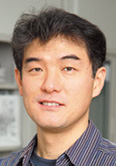
The aim of group B03 is to understand fundamental nature of quantum black holes by developing a new approach to quantum gravity that incorporates quantum information into general relativity. Black holes in general relativity are the simplest but one of the most mysterious objects in the universe since their basic constituent is merely the spacetime curvature, but they nevertheless possess thermodynamic properties, such as temperature and entropy. The possibility that a black hole can evaporate by emitting thermal Hawking radiation has raised the fundamental question, called the “black hole information paradox,” which concerns over general relativity and quantum information. The event horizon of a black hole is the causal boundary of domain of outer communications, whose structure and dynamics are governed by the null energy condition via the Einstein equations, and whose sectional area corresponds to the entropy, known as Bekenstein-Hawking entropy. The former aspect suggests that quantum mechanically corrected null energy conditions would play a significant role in understanding the structure and dynamics of quantum black holes. The latter aspect exhibits the close connection between the black hole entropy and quantum entanglement entropy, which characterizes the correlations between subsystems separated by a boundary surface in a larger quantum system. An increasing number of evidence shows that the black hole entropy can be described as an entanglement entropy via the gauge-gravity correspondence. Furthermore, recent development of the holographic principle indicates that geometric description of---not only a black hole event horizon but also---a various type of causal boundaries can admit the holographic description as a quantum entanglement via the Ryu-Takayanagi formula, which connects gravity with quantum information. It is thus anticipated that quantum aspects of gravity would become most tangible around causal boundaries and be described most effectively by using the language of quantum information theory. These observations form our view point of “extreme universe” that gravity/spacetime is a collection of quantum information. Based on these ideas, we will derive basic formulas that govern the dynamics of quantum black holes by unifying geometric and quantum information theoretic aspects of causal boundaries, and thereby attempt to establish a theoretical foundation for extreme universe.
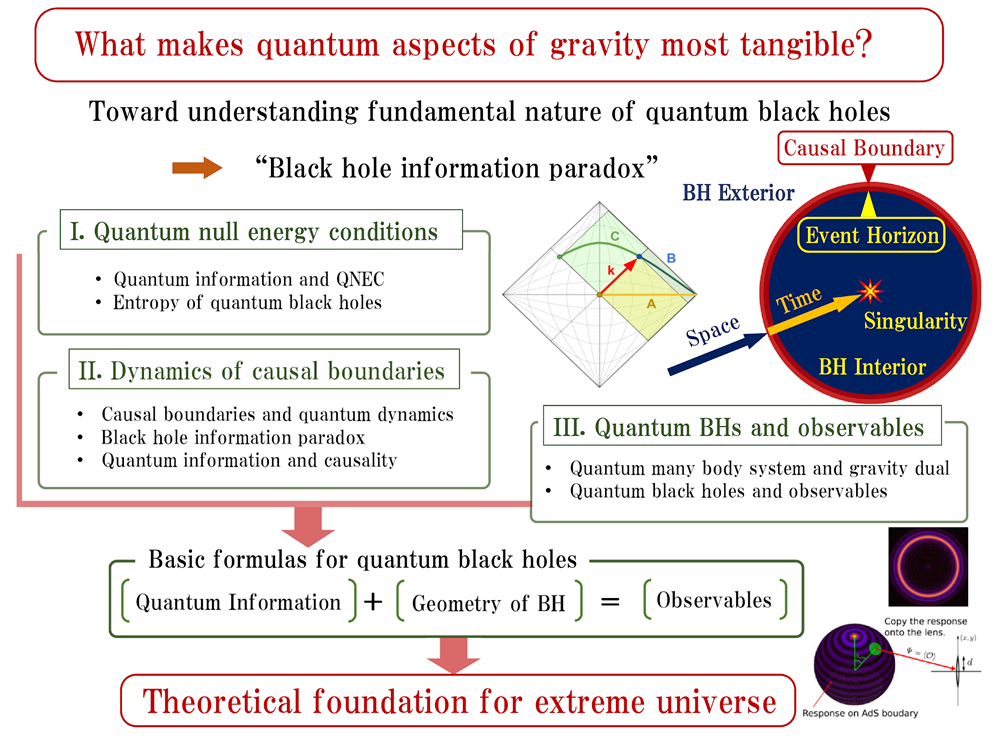
Members in B03
[Principal Investigator]
Akihiro Ishibashi(B03-PI)Graduate School of Science, Nagoya University
[Co-Investigator]
Kengo Maeda Faculty of Engineering, Shibaura Institute of Technology
Keiju Murata Department of Physics, Nihon University
[ExU Postdoctoral Fellow(Research Collaborators)]
Yoshinori Matsuo Department of Physics, Nagoya University
[Research Collaborators]
Takashi Okamura Department of Physics, Kwansei Gakuin University
Gen Kimura Systems Engineering and Science, Shibaura Institute of Technology
Toshifumi Noumi Graduate School of Arts and Sciences, The University of Tokyo
Shunichiro Kinoshita Academic Foundations Programs, Kanazawa Institute of Technology
[Post-doc Fellows]
Hiroki Matsui Department of Physics, Nihon University
[Graduate Students]
Koichiro Uehara Graduate School of Science, Nagoya University
Masanori Tomonaga Graduate School of Science, Nagoya University
Yuki Osawa Graduate School of Science, Nagoya University
Keiya Uemichi Graduate School of Science, Nagoya University
Rikuto Ohashi Graduate School of Science, Nagoya University
Palomino Ylla Ariadna Uxue Graduate School of Science, Nagoya University
Hiromasa Tajima Graduate School of Science, Nagoya University
Yusuke Makita Graduate School of Science, Nagoya University
Shin'ya Maeda Graduate School of Science, Nagoya University
Riku Yoshimoto Graduate School of Science, Nagoya University
Daichi Takagi Graduate School of Science, Nagoya University
Mizuki Matsutani Graduate School of Science, Nagoya University
